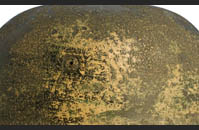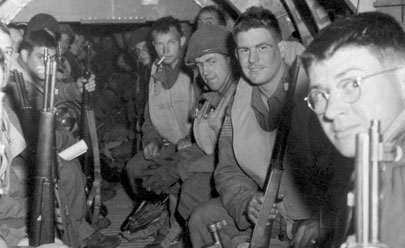SPECIAL EXHIBIT: SNAPSHOTS OF D-DAY:
Snapshots of D-Day: Photographs of the Normandy Invasion
June 2, 2012 – July 8, 2012
On view in the Joe W. and D.D. Brown Foundation Special Exhibit Gallery
Capturing some of the most dramatic moments of the 6 June 1944 invasion, Snapshots of D-Day: Photographs of the Normandy Invasion features images of combat on the beaches and in the hedgerows of Normandy. Making use of US Army Signal Corps, Coast Guard and Navy photographs as well as photos taken by individuals, this exhibit includes well-known and never-before-published images.
These images present the visitor with the ability to connect to this pivotal campaign in an up close and personal manner seldom possible through books or lectures.
 Also on display is a selection of helmets related to the Normandy campaign and a Korean War helmet issued to Major Richard Winters, former Easy Company Commander of the 506th Parachute Infantry Regiment during World War II. This collection is on loan from the Wilson History & Research Center.
Also on display is a selection of helmets related to the Normandy campaign and a Korean War helmet issued to Major Richard Winters, former Easy Company Commander of the 506th Parachute Infantry Regiment during World War II. This collection is on loan from the Wilson History & Research Center.
Featured Artifacts:
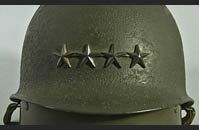 General William M. Hoge’s
General William M. Hoge’sM-1 Helmet
General William M. Hoge commanded the Provisional Engineer Special Brigade Group, which included both the 5th and 6th Engineer Special Brigades. His unit landed in Normandy on 6 June 1944, where they helped to secure the beachhead. The engineers played a significant role in creating a foothold on Omaha Beach.
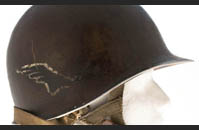 US M-1 Paratrooper Helmet
US M-1 Paratrooper HelmetThe winged foot identifies the original owner of this helmet as a member of 508th Parachute Infantry Regiment, 82nd Airborne Division. Unlike the 101st, the 82nd Airborne had seen combat before D-Day. However, the 508th was a green regiment that replaced the veteran 504th PIR, which was refitting after sustaining heavy casualties in the Italian campaign. Normandy was the 508th PIR’s first combat.
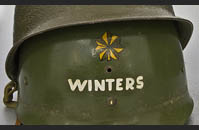 Major Richard Winters’
Major Richard Winters’Korean War M-1 Helmet
Richard “Dick” Winters was the ad-hoc commander of Easy Company, 506th Parachute Infantry Regiment, 101st Airborne Division during the Normandy campaign. He successfully led the assault that destroyed four German 105mm guns at Brécourt Manor on 6 June 1944. Winters wore this helmet after he was recalled during the Korean War to serve as a regimental training officer at Fort Dix, New Jersey, in 1952.
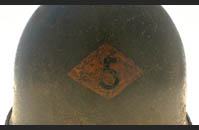 US M-1 Helmet from the 5th Ranger Battalion
US M-1 Helmet from the 5th Ranger BattalionThe 5th Ranger Battalion, along with the 29th and 1st Infantry Divisions, composed the initial assault waves at Omaha Beach. The German defense of Omaha was ferocious, inflicting heavy casualties and pinning down the survivors at the water’s edge. In an effort to rally the men around him, Norma Cota, the 29th’s assistant division commander, shouted to his men to get off the beach and move inland. Cota approached a group of pinned down soldiers and asked, “What outfit is this?” One of the soldiers answered, “5th Rangers,” to which Cota famously replied, “Well God damn it then, Rangers, lead the way!” The men fought their way off the beach and secured one of the first vehicle exits on Omaha beach that morning. “Rangers lead the way!” is the official motto of the US Army Ranger Regiment to this day.
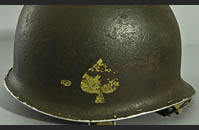 US M-1 Paratrooper Helmet
US M-1 Paratrooper HelmetThis M-1 helmet was worn by a paratrooper named L'Anthoen from the 506th Parachute Infantry Regiment (PIR), 101st Airborne Division. Visible on each side is the spade tactical insignia of the 506th PIR and its battalion tic marks. The tic marks are placed in the 9 o'clock position, signifying the 3rd Battalion.
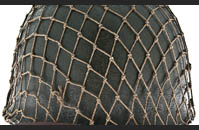 US M-2 Paratrooper Helmet Named to Private First Class Armand R. Beauchamp
US M-2 Paratrooper Helmet Named to Private First Class Armand R. BeauchampPFC Armand R. Beauchamp was a member of Fox Company, 2nd Battalion, 506th PIR. He participated in both the Normandy and Market Garden airborne operations. Beauchamp was killed in action at Opheusden, Holland, on the night of 6/7 October 1944, when a mortar round hit near his foxhole. The explosion also wounded his best friend, Roy Zerbe, who later underwent over forty reconstructive surgeries. Beauchamp's body was recovered from the dyke three days later by his company commander and others. Equipment that Beauchamp left behind, including this helmet, was collected and stored at a local building that was used for a short while as a field hospital. Once the Allies retreated from the area after Market Garden failed, the barn was never reoccupied, so Beauchamp’s helmet was not recovered during the war.
It was picked up after the war by Ben Overhand, who as a young boy accumulated American equipment and souvenirs for years, making him a well-known and respected Dutch collector. Robert Hoffman, a collector of SS militaria, obtained the helmet directly from Overhand and traded it to Kelly Hicks in 2001. Hicks later contacted Roy Zerbe and Dick Winters (former commander of Easy Company, 2nd Battalion, 506th PIR, 101st Airborne) about Beauchamp. They both remembered him as a handsome and dashing amateur actor from New Mexico.
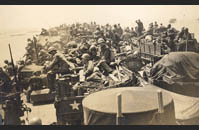 With the lower deck full of tanks, the top deck of LST-388 transported lighter vehicles. Many soldiers made the crossing on the open deck instead of in the crowded spaces below. After unloading, LSTs returned to England with casualties and prisoners.
With the lower deck full of tanks, the top deck of LST-388 transported lighter vehicles. Many soldiers made the crossing on the open deck instead of in the crowded spaces below. After unloading, LSTs returned to England with casualties and prisoners.
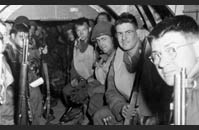 Soldiers of the 325th Glider Infantry Regiment, 82nd Airborne Division pose for one final photo before departing for Normandy in their British-made Horsa glider. Horsa gliders could accommodate more troops than the American Waco gilder, around 25 soldiers. Gliders were designed to land in a controlled crash that could result in high casualties.
Soldiers of the 325th Glider Infantry Regiment, 82nd Airborne Division pose for one final photo before departing for Normandy in their British-made Horsa glider. Horsa gliders could accommodate more troops than the American Waco gilder, around 25 soldiers. Gliders were designed to land in a controlled crash that could result in high casualties.
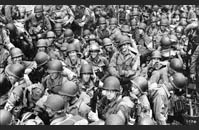 Members of the 101st Airborne Infantry Division and the 4th Infantry Division crowd aboard an LCT on the way to Utah Beach, June 6, 1944.
Members of the 101st Airborne Infantry Division and the 4th Infantry Division crowd aboard an LCT on the way to Utah Beach, June 6, 1944.
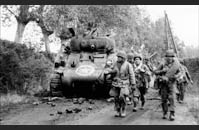 John Medusky took this picture of members of the 82nd Airborne walking through the hedgerows of Normandy past a disabled Sherman tank.
John Medusky took this picture of members of the 82nd Airborne walking through the hedgerows of Normandy past a disabled Sherman tank.
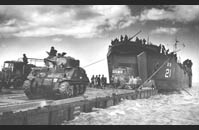 An LST (at right) unloads at a pier head inside the artificial Mulberry harbor. Mulberries, constructed in only days, allowed large amounts of material to be pushed ashore.
An LST (at right) unloads at a pier head inside the artificial Mulberry harbor. Mulberries, constructed in only days, allowed large amounts of material to be pushed ashore.
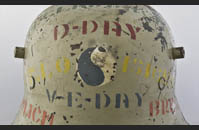 This is a German Model 1918 style helmet that was made into a souvenir by a member of the US 29th Infantry Division. The 29th sustained heavy casualties leading the assault on Omaha Beach.
This is a German Model 1918 style helmet that was made into a souvenir by a member of the US 29th Infantry Division. The 29th sustained heavy casualties leading the assault on Omaha Beach.
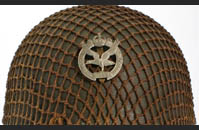 This helmet was worn by glider pilot Lieutenant Eric John Markwick.
This helmet was worn by glider pilot Lieutenant Eric John Markwick.
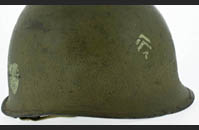 The markings on this helmet indicate that it was worn by a Technician 5th grade of the 3rd Battalion, 502nd Parachute Infantry Regiment, 101st Airborne Division.
This German paratrooper’s helmet was found in the Normandy region of France.
The markings on this helmet indicate that it was worn by a Technician 5th grade of the 3rd Battalion, 502nd Parachute Infantry Regiment, 101st Airborne Division.
This German paratrooper’s helmet was found in the Normandy region of France.